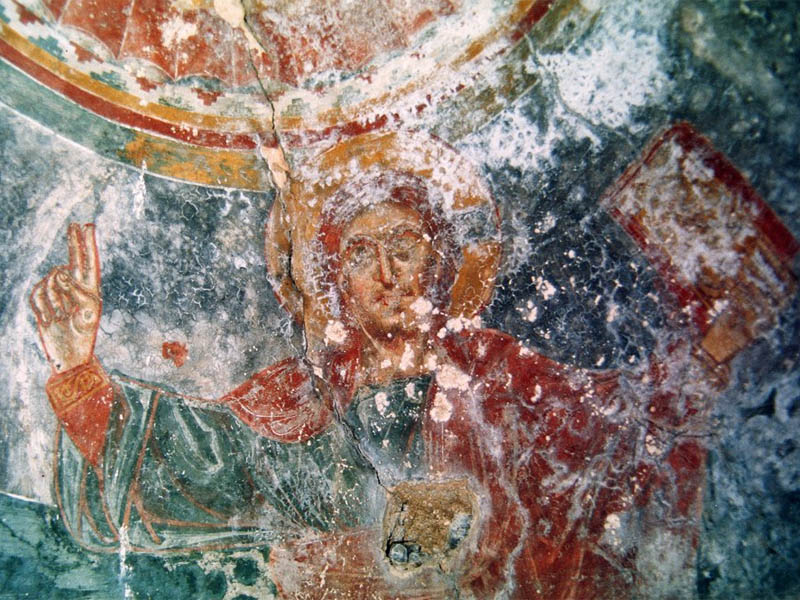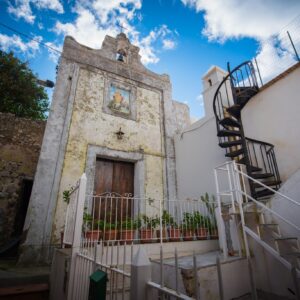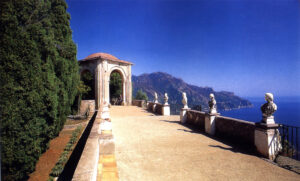MUNICIPALITY: Ravello
NAME: Antica Chiesa della Madonna della Pomice (Ancient Church of Madonna della Pomice)
LOCATION: Sambuco
DESCRIPTION:
The earliest records of the Pumice locality of Sambuco date back to the years between 998 and 1002, when the farmhouse was distinguished by vineyards, chestnut groves, fields, thickets, orchards and caves, as well as winemaking environments. It was precisely the cultivation of vines that became most widespread in the early 11th century, as a result of intense colonization activities, implemented by some native families, such as the de Maurone family. in the case of the Pumice locality. Within the farmhouses, where farming families worked and lived, a number of houses of worship began to be built, often of a private foundation, as was also presumably the case with the church of Santa Maria della Pumice or Pomice, over which, at the beginning of the 13th century, there was a patronage right of the Atranese Cappasanta family.
The apse decoration, which culminated in a fresco of Christ Pantocrator – ‘Lord of all things’ – also presumably dates from the late 13th century. By the middle of the seventeenth century, the church appeared to be well ornamented and equipped with many vestments, kept by the local lay administration, whose governors were Giovanni de Domenico and Gennaro de Manso, and who probably also took care of the two annual feasts celebrated in honor of the Virgin, the first one in the Octave of Easter, the second in August. A turn-of-the-century inventory, which appears in the margin of the verbal record of the 1694 Pastoral Visit made by Bishop Luigi Capuano, counted among the church’s precious objects three silver lamps and two crowns of the same material, applied to the painting, at the height of the heads of the Virgin and Child.
In 1982, following the simultaneous construction of a new parish complex (with a church and housing facilities), and presumably to cover a good part of the expenses necessary for its completion, with the consent of the Archiepiscopal Curia and the parishioners, the church of Santa Maria della Pomice was sold to private individuals, with a deed drawn up by Notary Pansa of Amalfi, dated July 12, imposing on the buyer the onus of renovating and preserving the apsidal area of the ancient church because of its sacred nature. A period of neglect followed, during which the church was also used as an animal shelter. In September 1991, the presence of the fresco in the apsidal basin was reported to the Soprintendenza ai Beni Ambientali, Architettonici, Artistici e Storici (Superintendence of Environmental, Architectural, Artistic and Historical Heritage), which was followed in August 1992 by a request for intervention by the “Ravello Nostra” Association.
SEE, VISIT, FIND: upon request.
FRUITION DATA: None
OPPORTUNITIES: the structures could be presented with exterior panels, so that the church would always be usable for visitors. Similar evidence, often little known, would be better enhanced by a tour itinerary (possibly guided) dedicated to the religious architecture of Ravello.
BIBLIOGRAPHY: FULCHIGNONI G., Ravello. Le cento chiese, Amalfi 2001
IMPERATO G., Ravello nella storia civile e religiosa,Cava d. T. 1990
MANSI L., Ravello sacra-monumentale, Ravello 1887
When “Luigi il Compagno” threatened: “churches will become pigsties!”
The construction of the church can be traced back to the 13th century, from the study conducted on the Byzantine fresco of Christ Pantocrator in the apse. In 1612 it was annexed to the Church of Santa Maria del Lacco. Sources indicate that in the mid-1700s was already built the residential appendix where a hermit, who evidently had the church in his care, lived. In the 1980s it was alienated in favor of private individuals, neglected, and used as an animal shelter until the “Ravello Nostra” Association pointed out the presence of frescoes of considerable artistic interest hidden behind a false wall. This started an initiative to reacquire it for public heritage supported by the City of Ravello.
Stefano Colonna
ISSN 1127-4883 BTA – Bollettino Telematico dell’Arte, 14 Giugno 2005, n. 40

The medieval fresco “del Salvatore” in the Church of Santa Maria della Pomice in Ravello.
One of the greatest satisfactions for those who find themselves in Ravello with a willingness to know consists in wandering through the woods of the mountains that dominate the Amalfi Coast and then suddenly discovering, amid dewy greens immersed in an almost tropical atmosphere – of humid and warm summer – the sober vestiges of a seventeenth-century building that discreetly protects parts of an older Byzantine factory.
In the crystalline and sometimes almost prehistoric greenery that surrounds these ancient medieval Ravellian villages, modestly sized churches located at the edge of the residential area have survived to this day, once populated by a community that was large in terms of the number of fires and mouths, but later diminished drastically.
Thanks to the recommendation of Don Giuseppe Imperato Jr., in 1991 I visited the small Church of Santa Maria della Pomice in the locality of Sambuco in the Municipality of Ravello located downstream of the road to the Valico di Chiunzi, guided by Antonio Ferrara – a connoisseur of Ravello history – together with Alberto White and my sister Serena.
The small, deconsecrated church is inhabited by a mule – or a donkey, so many years have passed and I no longer remember exactly… We pass behind it well aware that one kick from it can be fatal even for the sturdiest of rock climbers …
As we turn behind the seventeenth-century altar, we immediately get a view of a small but beautiful apsidal basin that shows in all its magnificence a brilliant example of Byzantine art, unfortunately in a precarious state of preservation. In fact, the plaster (tonachino*) – which is extremely thin and tends to detach from the wall, especially along the outer edges – presents a ragged surface, full of stains and encrustations of various kinds, although overall it maintains a fair legibility. It is immediately clear to me that the fresco is of fine medieval workmanship and deserves the highest consideration, although doubts had been raised about it.
We must note that in general the churches belonging to the type of Santa Maria della Pomice are brought to natural extinction because of their decentralized location in relation to a demographically poor territory, which over the centuries tends progressively to consolidate within the residential area, also for merely practical or defensive reasons. Most likely, the survival of this small church was due to a complex balance of strenuous survival of values of religious tradition, civic and toponymic historical memory, and, in more recent times, local history studies.
An authoritative acknowledgment
Also in 1991, having returned to Rome and being eager to obtain an authoritative confirmation of my dating of the fresco as a work of the medieval age, I submitted the photographic reproductions of the same to the analysis of Angiola Maria Romanini, a well-known researcher now deceased, who was then director of the Istituto di Storia dell’Arte Medioevale e Moderna dell’Università “La Sapienza” di Roma (Institute of the History of Medieval and Modern Art of the University “La Sapienza” of Rome).
Romanini, in the presence of Alessandro Tomei, told me at first glance and without any hesitation that the fresco could be compared to the executive quality of the ‘’second master of the Cathedral of Anagni.’’
Need for urgent restoration
The fresco has also been seen and studied by other competent scholars.
Today it certainly deserves a thorough stylistic, historical and documentary analysis, especially considering its urgent conservative restoration and a more thoughtful action of study, scientific publication of the existing materials, and also recovery, enhancement and protection of the whole monumental complex.





